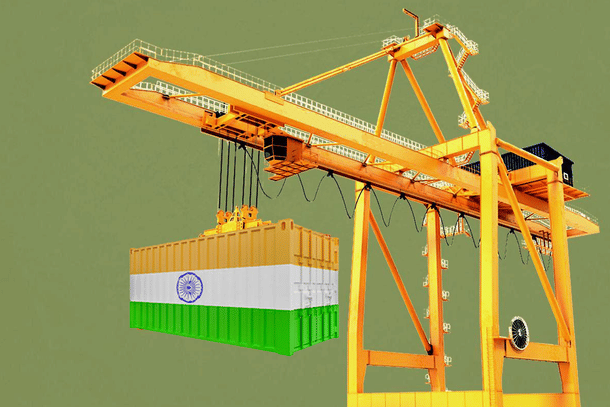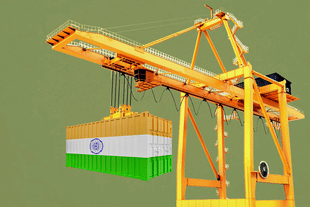Economics
How Modi Government Has Speeded Up Its Efforts To Increase Agricultural Exports, Double Farmers’ Income
M R Subramani
Aug 27, 2020, 02:50 PM | Updated 02:50 PM IST
Save & read from anywhere!
Bookmark stories for easy access on any device or the Swarajya app.


The Narendra Modi government took another important step in its efforts to increase agricultural exports to $60 billion and double the income of farmers by signing a memorandum of understanding (MoU) with a key financial organisation and a cooperative body.
The MoU will facilitate processing, value-addition and farm-to-fork development of agricultural products. The Agricultural and Processed Food Products Export Development Authority (APEDA), an arm of the Union Commerce Ministry, signed the MoU with AFC India Limited, formerly known as Agricultural Finance Corporation, and the National Cooperative Union of India (NCUI).
A Press Information Bureau (PIB) statement said that the MoU will help in the government tapping the expertise of both these organisations through mutual cooperation and synergising their activities in the farm sector. This would bring better value to all the stakeholders.
The development assumes significance in the wake of 20 cluster level committees being formed for potato (in Punjab, Uttar Pradesh), isabgol (in Rajasthan), orange, pomegranate, grapes and banana (in Maharashtra), banana (in Tamil Nadu and Kerala), mango (in Uttar Pradesh), dairy products (in Gujarat), rose onion (in Karnataka), fresh vegetables in (Uttar Pradesh), orange (in Madhya Pradesh), and potato (in Gujarat).
So far, 14 states in the country have come on board with regard to the agricultural export policy finalising state-specific action plans. Nagaland, Assam, Andhra Pradesh, Telangana, Manipur and Sikkim are the other six states apart from the eight above.
The PIB statement said that 26 states and three Union Territories have nominated nodal agencies, while state-level monitoring committees under state chief secretaries have been formed in 21 states.
The AFC will help identify and introduce critical technology for organic agricultural production, support value chain, carry out activities in export-oriented clusters, and encourage pre-production, production, post-harvest operations.
On its part, the NCUI will identify cooperatives and train them, while APEDA will facilitate the export of the product produced by them.
Besides, the Centre has roped in the National Cooperative Development Corporation and nearly 800 farmer producer organisations apart from setting up a market intelligence cell to prop up agricultural exports.
This brings the focus on to the Agricultural Export Policy that was announced in December 2018 but has gathered momentum now.
While the primary objective of the policy was to increase agricultural exports to top $60 billion in the next couple of years, it also enivsaged to double farmers’ income along with it.
This was planned through a 'farmer-centric approach' by opting for measures such as value-addition at source to cut losses across the value chain. It was for this reason that the Centre opted to adopt product-specific clusters in different agro-climatic zones.
This will help the stakeholders to deal with supply side issues such as soil nutrients, increasing production, adoption of varieties suitable for the market and taking up good agricultural practices.
The Modi government is of the view that its objective to nearly treble agricultural exports to $100 billion in the next few years will automatically boost farmers’ income. Agricultural exports are planned to be increased through diversification of the export basket, destination and boost high-value and value-added items.
Export of novel, ethnic, indigenous, organic and non-traditional agricultural products will also get a leg up under this policy. Towards this end, the government has come up with a two-pronged strategy.
The first is a strategic one and the second is operational. Under the strategic initiatives, the government will formulate policy plans, provide infrastructure logistics support, come up with a holistic approach to exports and ensure greater involvement of state governments.
On the operational front, the Centre decided to focus on clusters, promote value-addition, marketing and promotion of “Brand India”, attract private investment in processing, establish quality regimen and encourage research and development.
The Agricultural Export Policy had talked of Agricultural Produce Marketing Committee (APMC) reforms, which the Centre implemented in June through an ordinance.
The government has come up with a smart strategy to accord importance to the role of state government, which have been asked to include agricultural exports in their state export policy.
To give a push to infrastructure, the Centre plans to develop airports, seaports and road infrastructure. Similarly, it is encouraging lowering of ports landing and parking fees besides cutting down the aviation turbine fuel (ATF) tax.
Some states levy a higher ATF tax, which affects the competitiveness of exports of fresh and perishable agricultural products. The Centre also went in for cluster-based approach as it will help in more focussed pre and post harvest management of production.
This is considered crucial since the post-harvest losses are being pegged anywhere between 8 per cent and 18 per cent on account of poor management.
Overall, the government wanted to back up agricultural exports with infrastructure, institutional support, packaging, freight transport and providing market access to the international production system to transform the agricultural economy.
Until the agricultural export policy was announced, the agricultural export basket was made up primarily of rice ($6 billion), marine products ($5.8 billion) and meat ($4 billion) together contributing 52 per cent of earnings from agricultural products shipments. Also, value-addition in these products was minimal.
M.R. Subramani is Executive Editor, Swarajya. He tweets @mrsubramani




